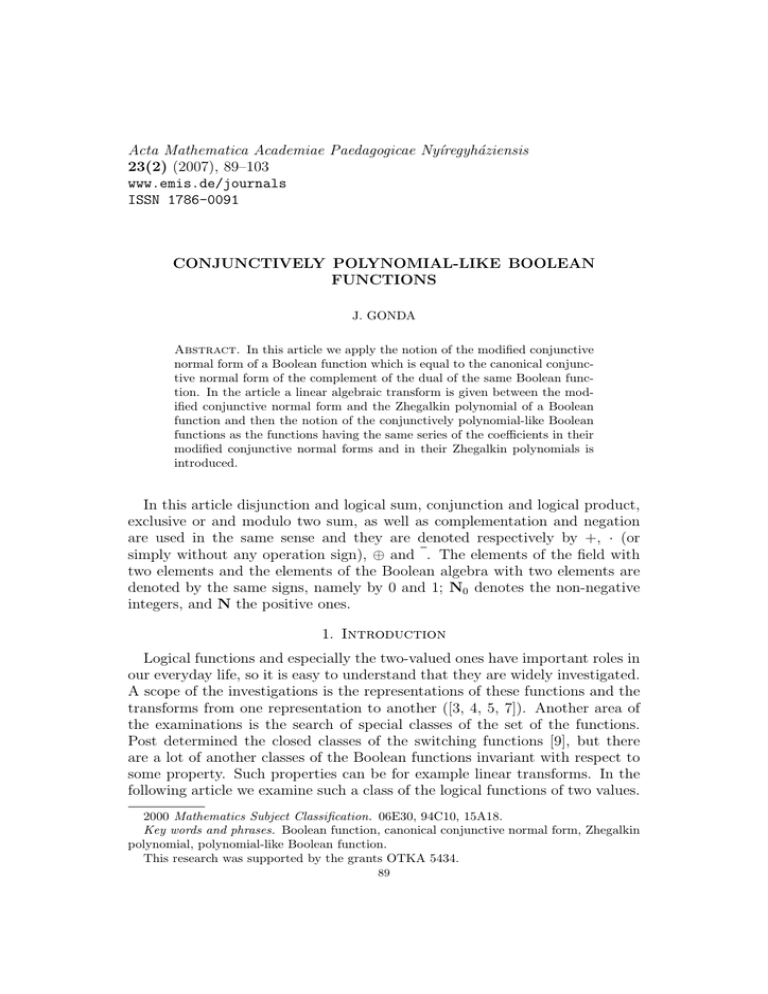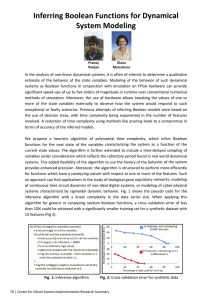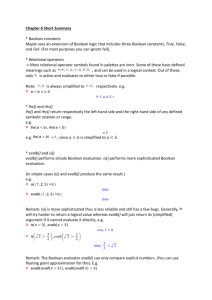Acta Mathematica Academiae Paedagogicae Ny´ıregyh´aziensis 23(2) (2007), 89–103 www.emis.de/journals ISSN 1786-0091
advertisement

Acta Mathematica Academiae Paedagogicae Nyı́regyháziensis
23(2) (2007), 89–103
www.emis.de/journals
ISSN 1786-0091
CONJUNCTIVELY POLYNOMIAL-LIKE BOOLEAN
FUNCTIONS
J. GONDA
Abstract. In this article we apply the notion of the modified conjunctive
normal form of a Boolean function which is equal to the canonical conjunctive normal form of the complement of the dual of the same Boolean function. In the article a linear algebraic transform is given between the modified conjunctive normal form and the Zhegalkin polynomial of a Boolean
function and then the notion of the conjunctively polynomial-like Boolean
functions as the functions having the same series of the coefficients in their
modified conjunctive normal forms and in their Zhegalkin polynomials is
introduced.
In this article disjunction and logical sum, conjunction and logical product,
exclusive or and modulo two sum, as well as complementation and negation
are used in the same sense and they are denoted respectively by +, · (or
simply without any operation sign), ⊕ and . The elements of the field with
two elements and the elements of the Boolean algebra with two elements are
denoted by the same signs, namely by 0 and 1; N0 denotes the non-negative
integers, and N the positive ones.
1. Introduction
Logical functions and especially the two-valued ones have important roles in
our everyday life, so it is easy to understand that they are widely investigated.
A scope of the investigations is the representations of these functions and the
transforms from one representation to another ([3, 4, 5, 7]). Another area of
the examinations is the search of special classes of the set of the functions.
Post determined the closed classes of the switching functions [9], but there
are a lot of another classes of the Boolean functions invariant with respect to
some property. Such properties can be for example linear transforms. In the
following article we examine such a class of the logical functions of two values.
2000 Mathematics Subject Classification. 06E30, 94C10, 15A18.
Key words and phrases. Boolean function, canonical conjunctive normal form, Zhegalkin
polynomial, polynomial-like Boolean function.
This research was supported by the grants OTKA 5434.
89
90
J. GONDA
It is well-known that an arbitrary two-valued logical function of n variables
can be written in the uniquely determined canonical disjunctive normal form,
i.e. as a logical sum whose members are pairwise distinct logical products of n
factors, where all of such logical products contain every logical variable exactly
once, either negated or not negated exclusively. Clearly, there exist exactly
2n such products. Supposing that the variables are indexed by the integers
0 ≤ j < n, these products can be numbered by the numbers 0 ≤ i < 2n
in such a way that we consider the non-negative integer containing 0 in the
j-th position of its binary expansion if the j-th variable of the given product is
negated, and 1 in the other case. Of course, this is a one to one correspondence
between the 2n distinct products and the integers of the interval [0 . . . 2n − 1],
P
(i) j
(i)
and if i = n−1
j=0 aj 2 , where aj is either 0 or 1, then the product belonging
to it is
n−1
´
Y ³ (i)
(n)
(1)
mi =
a j ⊕ xj .
j=0
Such a product is called minterm (of n variables).
With the numbering given above we numbered the Boolean functions of n
variables, too. A Boolean function is uniquely determined by the minterms
contained in its canonical disjunctive normal form, so a Boolean function is
uniquely determined by a 2n -long series of 0-s and 1-s, where a 0 in the j-th
(n)
position (now 0 ≤ j < 2n ) means that mj doesn’t occur in that function, and
1 means that the canonical disjunctive normal form of the function contains the
minterm of the index j (this series is the spectrum of the canonical disjunctive
normal form of the function, and similarly will be defined the spectrum with
Pn
(k)
respect to other representation of the function), i.e. for k = 2i=0−1 αi 2i with
(k)
αi ∈ {0, 1}
(n)
fk
(2)
=
n −1
2X
(k)
(n)
αi mi .
i=0
(n)
Now, fk denotes the k-th Boolean function of n variables.
A similar representation of a Boolean function is the canonical conjunctive
normal form of the function. Let’s consider
n−1 ³
´
X
(i)
(n)
aj ⊕ xj
(3)
Mi =
j=0
n
for 2 > i ∈ N0 . This function, the i-th maxterm of n variables is equal to 0
(i)
if and only if xj = aj for every 0 ≤ j < n. By these maxterms a Boolean
function can be expressed as
n −1
2Y
´
³
(n)
(n)
(4)
f =
αi + Mi
i=0
CONJUNTIVELY POLYNOMIAL-LIKE BOOLEAN FUNCTIONS
91
³
´
(i)
(i)
where αi = f (n) an−1 , . . . , a0 . From this last property follows that f (n) =
´
Q2n −1 ³
Pn
(n)
(n)
α
+
M
= fl where l = 2i=0−1 αi 2i .
i
i
i=0
For our present investigations it will be more convenient to introduce the
notion of the modified maxterm defined by
(n)0
(5)
Mi
=
n−1 ³
X
´
(i)
a j ⊕ xj .
j=0
(n)
Mi
(n)0
M2n −1−i .
(n)
´
Q2n −1 ³
(n)0
(n)
= i=0 βi + Mi
= fk
It is easy to see that
=
Now if f
³
´
(i)
(i)
then αi = f (n) an−1 , . . . , a0 = β2n −1−i . From now on we refer to this form
of the function given by the modified maxterms as the modified conjunctive
(i)
(i)
normal form of the function. For u ⊕ v = u ⊕ v, so aj ⊕ xj = aj ⊕ xj and
³
´
³
´
P
Qn
(n)0
(i)
(n)
(n)
Mi = n−1
= 2i=0−1 βi + Mi , then
j=0 aj ⊕ xj . If g
f (n) (xn−1 , . . . , x0 ) =
n −1
2Y
Ã
n−1 ³
´
X
(i)
a j ⊕ xj
αi +
i=0
=
(6)
=
j=0
n −1
2Y
³
i=0
n −1
2Y
!
αi +
(n)
Mi
´
=
n −1
2Y
³
i=0
Ã
βi +
i=0
n−1 ³
X
(i)
´
βi +
(n)0
Mi
´
!
aj ⊕ xj
j=0
= g (n) (xn−1 , . . . , x0 ) = g (n) (xn−1 , . . . , x0 )
= g (n)D (xn−1 , . . . , x0 )
where D denotes the dual of the function. As if f = g D then g = f D so g (n) is
the complement of the dual of f (n) in (6).
Another possibility for giving³ a Boolean
the so-called Zhegalkin´ function is P
Qn−1 (i)
(n)
n−1 (i) j
polynomial. Let Si = j=0 aj + xj , where i = j=0
aj 2 again. This
product contains only non-negated variables, and the j-th variable is contained
in it if and only if the j-th digit is 1 in the binary expansion of i. There
exist exactly 2n such products which are pairwise distinct. Now, any Boolean
function of n variables can be written as a modulo two sum of such terms, and
the members occurring in the sum are uniquely determined by the function.
That means that we can give the function by a 2n -long 0 - 1 series, and if the
i-th member of such a series is ki then
(7)
2n −1
(n)
f (n) = ⊕ ki Si .
i=0
92
J. GONDA
Between the first and the third representations of the same Boolean function
there is a very simple linear algebraic transform. Considering the coefficients
of the canonical disjunctive normal form of a Boolean function of n variables
and the coefficients of the Zhegalkin polynomial of a function of n variables,
respectively, as the components of an element of a 2n -dimensional linear space
over F2 , the relation between the vectors belonging to the two representations
of the same Boolean function of n variables can be given by k = A(n) α. Here
k is the vector containing the components of the Zhegalkin polynomial, α is
the vector, composed of the coefficients of the disjunctive representation of the
given function, and A(n) is the matrix of the transform in the natural basis.
For the matrix of the transform it is true that
(1)
µ
¶ if n = 0
(n)
(n−1)
(n−1)
A
0
(8)
A =
if n ∈ N
A(n−1) A(n−1)
(see for instance in [4]) and as a consequence that
(9)
2
A(n) = I(n) ,
where I(n) and 0(n) denote the 2n -dimensional identity and zero matrix, respectively. From this follows that if k = A(n) α, then α = A(n) k. In the special
case when α = k, the corresponding function is a polynomial-like Boolean
function [6]. As A(0) = (1), so each of the two zero variable Boolean functions
is polynomial-like. Now, let u = u0 u1 be the spectrum of the canonical disjunctive normal form of a Boolean function f of n + 1 variables, where n is a
nonnegative integer. Then
µ
¶ µ (n)
¶
¶µ
u0
A
0(n)
u0
(10)
=
u1
u1
A(n) A(n)
if and only if u0 = A(n) u0 and u1 = ¡A(n) u0 + A(n)
u1 = u0 + A(n) u1 , that is f is
¢
polynomial-like if and only if u0 = A(n) + I(n) u1 , where u1 is the spectrum
of the canonical disjunctive normal form of an arbitrary Boolean function of
n variables. As a consequence we get that the number of the n + 1 variable
n
polynomial-like Boolean functions is equal to 22 . It is easy to see, too, that
the spectra of the canonical disjunctive normal forms of the polynomial-like
Boolean functions of n + 1 variables make up a 2n -dimensional subspace of
the 2n+1 -dimensional linear space of the spectra of the canonical disjunctive
normal forms of all of the n + 1 variable Boolean functions.
Now, in the following parts of this article we deal with the relationship
between the modified conjunctive normal form and the Zhegalkin polynomial
of the function.
2. Development
Let β ← denote the vector the i-th component of which is equal to the 2n −1−
i-th component of β ∈ Fn2 . If P(n) is a 2n × 2n matrix with the elements Pi,j =
CONJUNTIVELY POLYNOMIAL-LIKE BOOLEAN FUNCTIONS
93
δ2n −1−i,j , that is with 1 in the side diagonal and with 0 at the
positions
¡ other
¢
(n)
(n)
(n) (n)
of the matrix, then α=β ← = P β. As k = A α, so k = A P β, that
is, denoting A(n) P(n) by U(n) ,
k = U(n) β.
(11)
Let’s investigate U(n) .
Theorem 1. U(0) = (1) and for n ∈ N0
µ (n)
¶
0
U(n)
(n+1)
(12)
U
=
.
U(n) U(n)
Proof. U(0) = A(0) P(0) = (1) (1) = (1) = I(0) , and
U(n+1) = A(n+1) P(n+1)
µ (n)
¶ µ (n)
¶
A
0(n)
0
P(n)
=
A(n) A(n)
P(n) 0(n)
µ
¶
0(n)
A(n) P(n)
=
A(n) P(n) A(n) P(n)
µ (n)
¶
0
U(n)
=
.
U(n) U(n)
(13)
¤
Theorem 2. U(n) is regular for any n ∈ N0 . The order of U(n) is equal to 1
if n = 0 and to 3 if n > 0.
3
3
3
Proof. U(0) = I(0) = I(0) . Supposing that U(n) = I(n) for an n ∈ N0 ,
µ (n)
¶ µ (n)
¶
0
U(n)
0
U(n)
(n+1)2
U
=
U(n) U(n)
U(n) U(n)
µ (n)2
(14)
2 ¶
U
U(n)
=
2
U(n)
0(n)
and
µ
(n+1)3
U
=
µ
(15)
=
µ
=
2
2
U(n) U(n)
2
0(n)
U(n)
3
U(n)
0(n)
I(n)
0(n)
¶µ
0(n) U(n)
U(n) U(n)
¶
¶
0(n)
3
U(n)
¶
0(n)
= I(n+1)
I(n)
3
so for any non-negative integer n, U(n) = I(n) . (13) and (14) show that
2
neither U(n+1) nor U(n+1) is equal to I(n+1) , so the order of U(n+1) is equal to
3. Finally it is obvious that the order of (1) is equal to 1.
¤
Now, we determine the invariant factors of U(n) .
94
J. GONDA
Theorem 3.
I(rn ×rn )
0(rn ×1)
0(rn ×sn )
,
(16)
U(n) + λI(n) ∼ 0(1×rn ) 1 + λ + εn λ2
0(1×sn )
0(sn ×rn )
0(sn ×1)
(1 + λ3 ) I(sn ×sn )
¥ n¦
where εn = n mod 2, sn = 23 and rn = 2n − 1 − sn .
Proof. If n = 0 then ε0 = s0 = r0 = 0 and U(0) = I(0) , so
U(0) + λI(0) = (1 + λ) .
(17)
In the case of n = 1, ε1 = 1 = r1 , s1 = 0 and
µ
¶
λ
1
(1)
(1)
U + λI =
1 1+λ
µ
¶
(18)
1
0
∼
0 1 + λ + λ2
and the two cases together give the following result for n = 0 and n = 1:
(r ×r )
I n n
0(rn ×1)
0(rn ×sn )
.
(19)
U(n) + λI(n) = 0(1×rn ) 1 + λ + εn λ2
0(1×sn )
(sn ×rn )
(sn ×1)
3
(sn ×sn )
0
0
(1 + λ ) I
Now, let n ∈ N0 . Then
µ
¶
λI(n+1)
U(n+1)
U
+ λI
=
(n+1)
U(n+1) + λI(n+1)
µ (n+1)U
¶
U
U(n+1) + λI(n+1)
∼
(20)
2
(n+1)
(n+1)
+ λI(n+1) + λ2 U(n+1) ¶
µ 0(n+1) U
I
0(n+1)
∼
(n+1)
(n+1)2
0
U
+ λU(n+1) + λ2 I(n+1)
µ (n+1)2
¶
U
U(n+1) + λI(n+1)
where in the second step we multiplied by
from
0(n+1)
U(n+1)
the right. Furthermore
¶
µ (n)2
2
+ λ2 I(n) U(n) + λU(n)
U
(n+1)2
(n+1)
2 (n+1)
U
+ λU
+λ I
=
2
U(n) + λU(n) λU(n) + λ2 I(n)
µ
2 ¶
U(n) + λI(n) λI(n) + λ2 U(n)
∼
2
2
U(n) + λ2 I(n) U(n) + λU(n)
(21)
µ (n)
2 ¶
U + λI(n) λI(n) + λ2 U(n)
∼
2
2
0(n)
U(n) + λ3 U(n)
¶
µ (n)
U + λI(n)
0(n)
.
∼
0(n)
(1 + λ3 ) I(n)
(n+2)
(n+2)
CONJUNTIVELY POLYNOMIAL-LIKE BOOLEAN FUNCTIONS
95
Putting this result into the matrix we got previously in (20)
µ (n+1)
¶
I
0(n+1)
(n+2)
(n+2)
U
+ λI
∼
2
0(n+1) U(n+1) + λU(n+1) + λ2 I(n+1)
n+1
n
n+1
n
(22)
I(n+1)
0(2 ×2 )
0(2 ×2 )
n
n+1
.
∼ 0(2 ×2 ) U(n) + λI(n)
0(n)
n
n+1
0(2 ×2 )
0(n)
(1 + λ3 ) I(n)
Let’s suppose that
(23)
U(n) + λI(n)
I(rn ×rn )
0(rn ×1)
0(rn ×sn )
∼ 0(1×rn ) 1 + λ + εn λ2
0(1×sn )
(sn ×rn )
(sn ×1)
3
(sn ×sn )
0
0
(1 + λ ) I
and let’s take into consideration that
¹ n º ¹ n+2 º
2
2
n
n
(24)
2 + sn = 2 +
=
= sn+2
3
3
and
2n+1 + rn = 2n+1 + 2n − 1 − sn
(25)
= 2n+2 − 1 − (2n + sn )
= 2n+2 − 1 − sn+2 = rn+2 .
Then substituting U(n) + λI(n) in (22) by the right hand side of (23), after
repartitioning the matrix we get that
(26)
U(n+2) + λI(n+2) ∼
(r ×r )
I n+2 n+2
0(rn+2 ×1)
0(rn+2 ×sn+2 )
.
∼ 0(1×rn+2 ) 1 + λ + εn+2 λ2
0(1×sn+2 )
(sn+2 ×rn+2 )
(sn+2 ×1)
3
(sn+2 ×sn+2 )
0
0
(1 + λ ) I
¤
With these results we know the minimal and the characteristic polynomial
of the transform belonging to U(n) , too, namely
Corollary 1. Let n ∈ N0 . The minimal polynomial of U(n) is
n=0
λ+1
(n)
2
λ +λ+1 n=1
(27)
m (λ) =
3
λ +1
n≥2
and the characteristic polynomial of the transform given by U(n) in the natural
basis of the 2n -dimensional Boolean space is
¡
¢sn
¡
¢εn
c(n) (λ) = λ3 + 1 (λ + 1)1−εn λ2 + λ + 1
(28)
¡
¢sn +εn
= (λ + 1)sn +(1−εn ) λ2 + λ + 1
.
96
J. GONDA
Proof. The minimal polynomial of a transform is its last invariant factor and
it is equal to that indicated in (17), (18) and (23), that is in (27). Similarly,
the characteristic polynomial is the product of all of the invariant factors of
the transform. In (23) we can see that λ3 + 1 is an invariant factor with
a multiplicity of sn , additionally if n is an even integer then λ + 1, and in
the other case λ2 + λ + 1 is a simple invariant factor, and there is no other
invariant factor. As λ3 +1 = (λ + 1) (λ2 + λ + 1) and the second operand of the
product is irreducible over F2 , we get also the second form of the characteristic
polynomial.
¤
Another consequence of Theorem 3 is the following corollary.
Corollary 2. The eigenvalue ofn the transform is 1 and the multiplicity of this
n
only eigenvalue is µn = 2 +2(−1)
.
3
By Corollary 2 the subspace of the 2n -dimensional Boolean space belonging
to the only eigenvalue of the transform determined
by the matrix U(n) =
n +2(−1)n
2
-dimensional.
A(n) P(n) in the natural basis of the space is
3
Proof. As the multiplicity of λ + 1 in c(n) (λ) is equal to sn + 1 − εn , and
λ2 + λ + 1 is irreducible over F2 , so the only eigenvalue of the transform is 1
with the multiplicity of µn = sn + 1 − εn and
¹ nº
2
µn = sn + 1 − εn =
+ 1 − (n mod 2)
3
2n − 2εn
=
+ 1 − (n mod 2)
3
(29)
2n − 1 − (n mod 2)
+ 1 − (n mod 2)
=
3
2n + 2 − 4 (n mod 2)
2n + 2 (−1)n
=
=
.
3
3
¤
Remark 1. Another way to gain µn is the recursion: µ0 = 1 and
2n+1 + 2 (−1)n+1
2 · 2n − 2 (−1)n
µn+1 =
=
3
3
(30)
2n + 2 (−1)n
− 2 (−1)n = 2µn − 2 (−1)n .
=2
3
We have to find a basis of this subspace.
¶
µ (n)
Q
R(n)
(n)
(n)
where Q(n) is a 2n − µn -order
Theorem 4. Let U + I =
S(n) T(n)
and T(n) is a µn -order quadratic matrix. Then Q(n) is regular, and the subspace
of the eigenvectors of the transform is
µ
¶
−1
Q(n) R(n)
(31)
u
I(µn ×µn )
CONJUNTIVELY POLYNOMIAL-LIKE BOOLEAN FUNCTIONS
97
where u is an arbitrary element of the µn -dimensional Boolean space.
Proof. If λ = 1 then U(n) + λI(n) = U(n) + I(n) . U(0) + I(0) = (0), so if n = 0,
then every element of the Boolean space, that is all of the Boolean functions of
0 variables are conjunctively polynomial-like. We get the same result by our
theorem, as now µ0 = 1 and so
µ
¶
−1
Q(0) R(0)
(32)
= I(0) .
I(µ0 ×µ0 )
If n = 1 then
µ
(1)
U
+I
(1)
=
µ
(33)
∼
0 1
1 1
1 1
0 1
¶
µ
+
¶
µ
∼
1 0
0 1
1 0
0 1
¶
µ
=
¶
1 1
1 0
¶
.
This matrix is regular, so its nullspace contains only the nullvector, the transform has no eigenvector, the only conjunctively polynomial-like Boolean function of one variable is the zero function of 1 variable. It is equal to we get by
the theorem: µ1 = 2µ0 − 2 (−1)0 = 0 and 21 − µ1 = 2, so U(1) = Q(1) and
µ
¶
−1
Q(1) R(1)
(34)
= ()
I(µ1 ×µ1 )
where () is a 2 × 0-matrix which spans the 0-dimensional subspace of the
2-dimensional Boolean space.
Now let n ≥ 0. Then
µ (n+1)
¶
I
U(n+1)
(n+2)
(n+2)
U
+I
=
U(n+1) U(n+1) + I(n+1)
µ (n+1)
¶
(35)
I
U(n+1)
∼
2
0(n+1) U(n+1) + U(n+1) + I(n+1)
µ
¶
2
2
U(n) + I(n) U(n) + U(n)
(n+1)2
(n+1)
(n+1)
U
+U
+I
=
2
U(n) + U(n) U(n) + I(n)
(36)
µ
¶
2
U(n) + I(n) U(n) + I(n)
∼
0(n)
0(n)
and so
(n)
I
0(n)
0(n)
U(n)
0(n) I(n)
U(n)
U(n)
.
(37)
U(n+2) + I(n+2) ∼
2
(n)
(n)
(n)
(n)
(n)
(n)
0
0
U +I
U
+I
0(n) 0(n)
0(n)
0(n)
From here it is easy to see by induction that the left upper (2n − µn )×(2n − µn )
submatrix of U(n) + I(n) is regular (as we manipulated only the rows of the
matrix, and we added a multiple of a row to another row always downwards),
98
J. GONDA
and this regular submatrix can’t be extended regularly due to the rank of the
matrix. If
µ (n)
¶
Q
R(n)
(n)
(n)
(38)
U +I =
S(n) T(n)
¡
¢
where Q(n) is the above mentioned regular submatrix, then U(n) + I(n) u = 0
if and only if
µ
¶
−1
n
¢
Q(n)
0((2 −µn )×µn ) ¡ (n)
(2n )
(n)
=
U
+
I
u
0
−1
S(n) Q(n)
I(µn ×µn )
µ
¶ µ (n)
¶ µ (0) ¶
−1
n
Q(n)
0((2 −µn )×µn )
Q
R(n)
u
(39)
=
(n)
(n)
(n) (n)−1
(µn ×µn )
S
T
u(1)
S Q
I
µ
¶ µ (0) ¶
−1
n
n
u
I((2 −µn )×(2 −µn )) Q(n) R(n)
=
(µn ×(2n −µn ))
(µn ×µn )
u(1)
0
0
that is if and only if
¶
µ
¡
¢ u(0)
n
−1
n −µ )×(2n −µ ))
((2
(n)
(n)
n
n
(40)
= 0(2 −µn ) .
I
Q
R
(1)
u
From this equation we get that
µ (0) ¶ µ
¶
−1
u
Q(n) R(n)
(41)
=
u(1)
u(1)
I(µn ×µn )
is the solution of the equation
µ (n)
¶ µ (0) ¶ µ (2n −µ ) ¶
n
Q
R(n)
u
0
(42)
=
S(n) T(n)
u(1)
0(µn )
with an arbitrary u(1) vector of the µn -dimensional Boolean space.
¤
Finally, we define the class of the Boolean functions having the properties
we dealt with in this article.
Definition 1. Let f be a Boolean function of n variables, and let β and k be
the spectra of the modified conjunctive normal form and the Zhegalkin polynomial of f , respectively. Then f is a conjunctively polynomial-like Boolean
function, if β = k.
Example 1. Let n = 2.
U(2) + I(2)
(43)
1
0
=
0
1
1
0
∼
0
0
0
1
1
1
0
1
1
1
0
1
0
0
0
1
0
0
1
1 0
1 0 1
∼
1 0 1
0
0 1
1
µ
1
I(1)
=
0
0(1)
0
0
1
1
1
1
1
1
1
−1
Q(2) R(2)
0(1)
¶
.
CONJUNTIVELY POLYNOMIAL-LIKE BOOLEAN FUNCTIONS
Then
µ
(44)
1
1
0
1
0
¶
1
=
1
0
−1
Q(2) R(2)
I(2×2)
99
and the two-variable conjunctively polynomial-like Boolean functions are as
follows:
(2)
(2)0
M0
(2)0
M1
(2)0
M2
(2)0
M3
(45)
f0
0
0
0
0
(2)
f13
1
1
0
1
(2)
0+
(2)0
M2
f6
0
1
1
0
(2)
f11
1
0
1
1
Really,
³
0+
(2)0
M0
´³
0+
(2)0
M1
(2)0
´³
(2)0
(2)0
´³
0+
(2)0
M3
´
(2)0
= M0 M1 M2 M3
(46)
= (x1 + x0 ) (x1 + x0 ) (x1 + x0 ) (x1 + x0 )
= 0 = 0 · S0 + 0 · S1 + 0 · S2 + 0 · S3
³
(2)0
´³
0 + M0
(2)0
´³
1 + M1
(2)0
(2)0
´³
1 + M2
(2)0
´
0 + M3
(2)0
= M0 M3 = (x1 + x0 ) (x1 + x0 )
= x1 x0 + x1 x0 = x1 ⊕ x0
= 0 · S0 + 1 · S1 + 1 · S2 + 0 · S3
(47)
³
(2)0
´³
(2)0
´³
1 + M1
1 + M0
(2)0
´³
0 + M2
(2)0
´
1 + M3
(2)0
= M2 = (x1 + x0 )
= 1 ⊕ x0 ⊕ x1 x0
= 1 · S0 + 1 · S1 + 0 · S2 + 1 · S3
(48)
and finally
³
(2)0
1 + M0
(49)
´³
(2)0
0 + M1
(2)0
´³
(2)0
1 + M2
´³
(2)0
1 + M3
= M1 = (x1 + x0 )
= 1 ⊕ x1 ⊕ x1 x0
= 1 · S0 + 0 · S1 + 1 · S2 + 1 · S3 .
´
100
J. GONDA
Example 2. Let n = 3. Now,
(50)
A(3)
=
1
1
1
1
1
1
1
1
(51)
U(3) + I(3)
=
0
1
0
1
0
1
0
1
0
0
1
1
0
0
1
1
0
0
0
1
0
0
0
1
0
0
0
0
1
1
1
1
0
0
0
0
0
1
0
1
0
0
0
0
0
0
1
1
0
0
0
0
0
0
0
1
1
0
0
0
0
0
0
1
0
1
0
0
0
0
1
1
0
0
1
0
0
1
0
1
0
0
0
1
1
1
1
1
0
0
0
1
1
0
0
1
0
0
1
1
0
1
1
1
0
1
0
1
0
1
1
1
0
0
0
1
1
0
0
0
1
1
0
1
and µ3 = 2µ2 − 2 (−1)2 = 2, 23 − µ3
1
0
0
(52)
Q(3) =
0
0
0
= 6, so
0
1
0
0
0
0
0
0
1
0
0
1
0
0
0
1
1
1
0
1
0
1
0
1
1
1
1
1
1
1
and
R(3)
(53)
=
.
Then,
(54)
−1
Q(3)
=
1
0
0
0
0
0
0
1
0
0
0
0
0
0
1
1
1
0
0
0
1
0
0
1
0
0
1
0
1
1
0
0
0
1
1
0
1
1
1
1
1
1
1
0
CONJUNTIVELY POLYNOMIAL-LIKE BOOLEAN FUNCTIONS
101
and
µ
(55)
−1
Q(3) R(3)
I(2×2)
¶
=
0
1
1
1
1
1
1
0
1
1
1
0
1
0
0
1
0
0
0
0
1
1
1
1
0
0
0
1
0
0
0
1
.
Really,
µ
(3)
U
−1
Q(3) R(3)
I(1)
¶
=
(56)
=
0
0
0
0
0
0
0
1
0
0
0
0
0
0
1
1
0
1
1
1
1
1
1
0
1
1
1
0
1
0
0
1
0
0
0
0
0
1
0
1
0
0
1
1
0
0
1
1
0
1
0
1
0
1
0
1
1
1
1
1
1
1
1
1
0
1
1
1
1
1
1
0
1
1
1
0
1
0
0
1
µ
¶
−1
Q(3) R(3)
=
I(1)
that shows that the columns of
µ
−1
Q(3) R(3)
I(2×2)
¶
are eigenvectors of the transform. From here we get the four conjunctively
polynomial-like Boolean functions of three variables as the four linear combinations of the two columns of the matrix of the right hand side of the equation
102
J. GONDA
(55). Namely,
(3)
(3)0
(57)
M0
(3)0
M1
(3)0
M2
(3)0
M3
(3)0
M4
(3)0
M5
(3)0
M6
(3)0
M7
f0
0
0
0
0
0
0
0
0
(3)
(3)
(3)
f126 f233 f151
0
1
1
1
1
0
1
1
0
1
0
1
1
1
0
1
0
1
1
0
1
0
1
1
3. Conclusion
In the article above we dealt with a special transform of the Boolean functions given between the spectrum of the Zhegalkin polynomial of a Boolean
function and the vector containing the elements of the spectrum of the canonical disjunctive normal form of the same function in reversed order. It was
stated that the order of the transform is equal to three (with the exception
of the case of n = 0). The set of the functions of n variables invariant with
respect to this transform is a linear subspace of the linear space of all of the
n-variable Boolean
functions and the dimension of this subspace is equal to
2n +2(−1)n
µn =
. In the article we gave a basis of this subspace, too. If U(n)
3
denotes the matrix of the transform
the rank of U(n) + I(n) is equal to
µ (n) then
¶
(n)
Q
R
2n − µn and U(n) + I(n) =
, where Q(n) is a 2n − µn -order
(n)
S
T(n)
µ
¶
−1
Q(n) R(n)
regular quadratic matrix. Then the columns of
make up a
I(µn ×µn )
basis of the transform.
References
[1] S. H. Akers. On the theoiry of Boolean functions. J. SIAM., 7:487–498, 1959.
[2] R. Beigel. The polynomila method in circuit complexity. In 36th Annual Symposium on
Foundations of Computer Science, IEEE Conference Proceedings, pages 82–95, 1995.
[3] P. Calingaert. Switching functions: canonical forms based on commutative and associative binary operations. Trans. AIEE, 1961.
[4] M. Davio, J.-P. Deschamps, and A. Thayse. Discrete and switching functions. Georgi
Publishing Co., St., 1978. With a foreword by Raymond T. Yeh.
[5] J. Gonda. Transformation of the canonical disjunctive normal form of a Boolean function
to its Zhegalkin-polynomial and back. Ann. Univ. Sci. Budapest. Sect. Comput., 20:147–
156, 2001.
[6] J. Gonda. Polynomial-like Boolean functions. Ann. Univ. Sci. Budapest. Sect. Comput.,
25:13–23, 2005.
[7] R. J. Lechner. Harmonic analysis of switching functions. In Recent Developments in
Switching Theory, pages 121–228. Academic Press, New York, 1971.
CONJUNTIVELY POLYNOMIAL-LIKE BOOLEAN FUNCTIONS
103
[8] E. L. Post. Introduction to a General Theory of Elementary Propositions. Amer. J.
Math., 43(3):163–185, 1921.
[9] E. L. Post. The Two-Valued Iterative Systems of Mathematical Logic. Annals of Mathematics Studies, no. 5. Princeton University Press, Princeton, N. J., 1941.
Received July 28, 2005; 31 January, 2007 in revised form.
Eötvös Loránd Universitiy,
Faculty of Informatics,
Department of Computer Algebra,
H1117 Budapest,
Pázmány Péter sétány 1/c.
E-mail address: andog@compalg.inf.elte.hu






